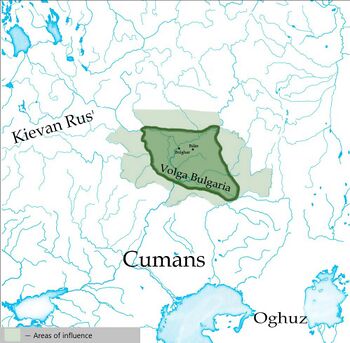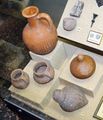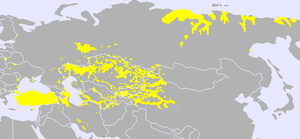بلغاريا الفولغا
بلغاريا الڤولگا | |||||||||
|---|---|---|---|---|---|---|---|---|---|
| 7th century–1240s | |||||||||
 | |||||||||
| العاصمة | بلغار بيلار | ||||||||
| اللغات المشتركة | Bulgar | ||||||||
| الدين | Tengrism، ولاحقاً الإسلام السني (بعد Almish Iltäbär) | ||||||||
| الحكومة | ملكية | ||||||||
| Ruler, خان، أمير | |||||||||
• القرن التاسع | Irhan, Tuqyi, Aidar, Şilki, Batyr-Mumin | ||||||||
• القرون 10-12 | Almish Yiltawar، ميكائيل بن جعفر، أحمد بن جعفر, عبد الله بن ميكائيل، طالب بن أحمد، مؤمن بن الحسن، مؤمن بن أحمد، عبد الرحمن بن مؤمن، أبو إسحاق إبراهيم بن محمد، ناظر الدين | ||||||||
• القرن 13 | Ghabdula Chelbir | ||||||||
| الحقبة التاريخية | Middle Ages | ||||||||
• تأسست | 7th century | ||||||||
• اعتناق الإسلام | 922 | ||||||||
| 1240s | |||||||||
| |||||||||
| اليوم جزء من | روسيا | ||||||||
جزء من سلسلة عن |
|---|
| تاريخ تتارستان |
 |
بلغاريا الڤولگا (Volga Bulgaria ؛ بالتتارية: Идел буе Болгары, بالچواشية: Атăлçи Пăлхар) or Volga–Kama Bulghar, was a historic Bulgar[1][2][3] state that existed between the 7th and 13th centuries around the confluence of the Volga and Kama River, in what is now European Russia. Volga Bulgaria was a multi-ethnic state with large numbers of Turkic Bulgars, a variety of Finnic and Ugric peoples, and many East Slavs.[4] The very strategic position of Volga Bulgaria allowed it to create a monopoly between the trade of Arabs, Norse and Avars.[5]
. . . . . . . . . . . . . . . . . . . . . . . . . . . . . . . . . . . . . . . . . . . . . . . . . . . . . . . . . . . . . . . . . . . . . . . . . . . . . . . . . . . . . . . . . . . . . . . . . . . . . . . . . . . . . . . . . . . . . . . . . . . . . . . . . . . . . . . . . . . . . . . . . . . . . . . . . . . . . . . . . . . . . . . .
التاريخ
الأصل وخلق الدولة
The Bulgars were Turkic tribes of Oghur origin,[6][7] who settled north of the Black Sea. During their westward migration across the Eurasian steppe, they came under the overlordship of the Khazars, leading other ethnic groups, including Finnic and Iranic peoples.[6] About 630 they founded Old Great Bulgaria which was destroyed by the Khazars in 668. Kubrat's son and appointed heir Batbayan Bezmer moved from the Azov region in about AD 660, commanded by the Kazarig Khagan Kotrag to whom he had surrendered. They reached Idel-Ural in the eighth century, where they became the dominant population at the end of the 9th century, uniting other tribes of different origin which lived in the area.[8] Some Bulgar tribes, however, continued westward and eventually settled along the Danube River, in what is now known as Bulgaria proper, where they created a confederation with the Slavs, adopting a South Slavic language and the Eastern Orthodox faith.
Most scholars agree that the Volga Bulgars were initially subject to the Khazarian Khaganate. This fragmented Volga Bulgaria grew in size and power and gradually freed from the influence of the Khazars. Sometime in the late 9th century unification processes started, and the capital was established at Bolghar (also spelled Bulgar) city, 160 km south from modern Kazan. However complete independence was reached after Khazaria's destruction and conquest by Sviatoslav in the late 10th century, thus Bulgars no longer paid tribute to it.[9][10]
Abu al-Ghazi Bahadur named the Volga Bulgar people as Ulak.[11]
اعتناق الإسلام وتشكل الدولة
Volga Bulgaria adopted Islam in 922 – 66 years before the Christianization of Kievan Rus'. In 921 Almış sent an ambassador to the Caliph requesting religious instruction. Next year an embassy returned with Ibn Fadlan as secretary. A significant number of Muslims already lived in the country.[12]
The Volga Bulgars attempted to convert Vladimir I of Kiev to Islam; however Vladimir rejected the notion of Rus' giving up wine, which he declared was the "very joy of their lives".[13]
Commanding the Volga River in its middle course, the state controlled much of trade between Europe and Asia prior to the Crusades (which made other trade routes practicable). The capital, Bolghar, was a thriving city, rivalling in size and wealth with the greatest centres of the Islamic world. Trade partners of Bolghar included from Vikings, Bjarmland, Yugra and Nenets in the north to Baghdad and Constantinople in the south, from Western Europe to China in the East. Other major cities included Bilär, Suar (Suwar), Qaşan (Kashan) and Cükätaw (Juketau). Modern cities Kazan and Yelabuga were founded as Volga Bulgaria's border fortresses. Some of the Volga Bulgarian cities still have not been found, but they are mentioned in old East Slavic sources. They are: Ashli (Oshel), Tuxçin (Tukhchin), İbrahim (Bryakhimov), Taw İle. Some of them were ruined during and after the Golden Horde invasion.[بحاجة لمصدر]
The Rus' principalities to the west posed the only tangible military threat. In the 11th century, the country was devastated by several raids by other Rus'. Then, at the turn of the 12th and 13th centuries, the rulers of Vladimir (notably Andrew the Pious and Vsevolod III), anxious to defend their eastern border, systematically pillaged Volga Bulgarian cities. Under Rus' pressure from the west, the Volga Bulgars had to move their capital from Bolghar to Bilär.[بحاجة لمصدر]
الانحدار

في سبتمبر 1223 near Samara an advance guard of Genghis Khan's army under command of Uran, son of Subutai Bahadur,قالب:Disputed inline entered Volga Bulgaria but was defeated in the Battle of Samara Bend.[بحاجة لمصدر] في 1236، عاد المنغول[بحاجة لمصدر]. ومنذ ذلك الحين أصبحت بلغاريا الڤولگا جزءاً من أولوس جوچي، التي عـُرِفت لاحقاً بإسم القبيل الذهبي. It was divided into several principalities; each of them became a vassal of the Golden Horde and received some autonomy. وبحلول عقد 1430، كانت خانية قازان قد تأسست كأهم تلك الإمارات.[بحاجة لمصدر]
اللغة
Volga Bulgar language was an Oghuric language. The only extant member of the Oghuric group that is still spoken today is the Chuvash language. The language persisted in the Volga region up until the 13th or 14th century. Although there is no direct evidence, some scholars believe it gave rise to modern Chuvash language[14][15][16][17] while others support the idea Chuvash is an another distinct Oghur Turkic language.[18]
Italian historian and philologist Igor de Rachewiltz noted a significant distinction of the Chuvash language from other Turkic languages. According to him, the Chuvash language does not share certain common characteristics with Turkic languages to such a degree that some scholars consider Chuvash as an independent branch from Turkic and Mongolic. The Turkic classification of Chuvash was seen as a compromise solution for classification purposes.[19]
Definition of verbs in Volga Bulgar[20][21]
| Tenses and moods | Volga Bulgar | Examples in words |
|---|---|---|
| Past tense | -ti/tı, -ri/rı | وَلتِ (vel-ti) |
| Past tense 2 | -ruvı/rüvi (<*-dugı), -tuvı/tüvi (<*-tugı) | كُوَجڔوُي (küveč-rüvi), بلطُوى (bal-tuvı) |
| Adjective form of verb | -an/en | طَنَان (tan-an), سَوَان (sev-en) |
| Adverb form of verb | -sa/se | بَرسَ (bar-sa) |
| Third person imperative | -tur/tür | طَنْطُرْ (tan-tur) |
Volga Bulgars left some inscriptions in tombstones. There are few surviving inscriptions in the Volga Bulgar language, as the language was primarily an oral language and the Volga Bulgars did not develop a writing system until much later in their history.[22] After converting to Islam, some of these inscriptions were written using Arabic letters while the use of the Orkhon script continued. Mahmud al-Kashgari provides some information about the language of the Volga Bulgars, whom he refers to as Bulghars. Some scholars suggest Hunnic had strong ties with Bulgar and to modern Chuvash[23] and classify this grouping as separate Hunno-Bulgar languages.[24] However, such speculations are not based on proper linguistic evidence, since the language of the Huns is almost unknown except for a few attested words and personal names. Scholars generally consider Hunnish as unclassifiable.[25][26][27][28]
Numbers and Vocabulary in Volga Bulgar[21][20][29][30][31][32][33]
| Volga Bulgar[34][35][29] | Chuvash[36] | Oghuric | |
|---|---|---|---|
| one | بر (bir) | пӗр (pĕr) | *bīr |
| two | اک (eki) | иккӗ (ikkĕ) | *ẹki |
| three | وج (več) | виççӗ (viççĕ) | *üč |
| four | تُوات (tüvet) | тăваттă (tăvattă) | *tȫrt |
| five | بل (bel), بيال (biyel) | пиллӗк (pillĕk) | *bẹ̄ĺ(k) |
| six | اَلطِ (altï) | улттӑ (ulttă) | *altï |
| seven | جىَاتِ (cyeti) | ҫиччӗ (śiččĕ) | *yẹti |
| eight | ڛَكِڔ (sekir) | саккӑр (sakkăr) | *sekiŕ |
| nine | طُخِڔ (tuxïr) | тӑххӑр (tăhhăr) | *tokuŕ |
| ten | وان (van) | вуннӑ (vunnă) | *ōn |
| twenty | جِيِرم (ciyirim) | ҫирӗм (śirĕm) | *yẹgirmi |
| thirty | وطر (vutur) | вӑтӑр (văt̬ăr) | *otuŕ |
| forty | حرح (xïrïx) | хӗрӗх (hĕrĕh) | *kïrk |
| fifty | الو (ellü) | аллӑ (allă) | *ellig |
| hundred | جُور (cǖr) | ҫӗр (śĕr) | *yǖŕ |
Mahmud al-Kashgari also provides some examples of Volga Bulgar words, poems, and phrases in his dictionary.. However, Mahmud al-Kashgari himself wasn't a native speaker of Volga Bulgar. Despite its limitations, Mahmud al-Kashgari's work remains an important source of information about the Volga Bulgar language and its place within the broader Turkic language family.
| Case | Volga Bulgar | Examples in words |
|---|---|---|
| Genitive | -∅ or -(ı)n | اَغَان (ağā-n), يغقوُتن (yaquut-ın) |
| Accusative | -ne/na | مَسجِذڛَمنَ (mesčidsem-ne) |
| Dative-locative | -a/e and -ne/na | اِشنَ (iš-ne), بَجنَ (bač-na), جَالَ (čāl-a) |
| Ablative | -ran, -ren; -tan, -ten | ڊنيَاڔَان (dönyā-ran) |
| Third person possessive | -i, -ı; -si, -sı | هِيرِ (hīr-i), اِلغِجِڛِ (ılğıčı-sı) |
السكان
A large part of the region's population included Turkic groups such as Sabirs, Barsil, Bilars, Baranjars, and part of the obscure[37] Burtas (by ibn Rustah). Modern Chuvashes claim to descend from Sabirs and Kazan Tatars from the Volga Bulgars.[38]
Another part comprised Volga Finnic and Magyar (Asagel and Pascatir) tribes, from which Bisermäns probably descend.[39] Ibn Fadlan refers to Volga Bulgaria as Saqaliba, a general Arabic term for Slavic people. Other researches tie the term to the ethnic name Scythian (or Saka in Persian).[40]
According to some historians[بحاجة لمصدر], over 80% of the country's population was killed[بحاجة لمصدر] during the invasion. The remaining population mostly relocated to the northern areas[بحاجة لمصدر] (territories of modern Chuvashia and Tatarstan). Some autonomous duchies appeared in those areas.
Over time, the cities of Volga Bulgaria were rebuilt and became trade and craft centers of the Golden Horde. Some Volga Bulgars, primarily masters and craftsmen, were forcibly moved to Sarai and other southern cities of the Golden Horde. Volga Bulgaria remained a center of agriculture and handicraft.[بحاجة لمصدر]
. . . . . . . . . . . . . . . . . . . . . . . . . . . . . . . . . . . . . . . . . . . . . . . . . . . . . . . . . . . . . . . . . . . . . . . . . . . . . . . . . . . . . . . . . . . . . . . . . . . . . . . . . . . . . . . . . . . . . . . . . . . . . . . . . . . . . . . . . . . . . . . . . . . . . . . . . . . . . . . . . . . . . . . .
معرض صور
انظر أيضاً
- خط زمني للترك (500-1300)
- Atil
- Balymer
- خانية قازان
- قل علي
- معركة ثنية سمارا
- تتار
- بلغاريا الكبرى القديمة
- هون
المراجع
- ^ Nicolle, David (2013). Armies of the Volga Bulgars & Khanate of Kazan. p. 14.
- ^ Champion, Timothy (2014). Nationalism and Archaeology in Europe. p. 227.
- ^ Koesel, Karrie J. (2014). Religion and Authoritarianism: Cooperation, Conflict, and the Consequences. p. 103.
- ^ The New Cambridge medieval history. McKitterick, Rosamond. Cambridge [England]: Cambridge University Press. 1995–2005. ISBN 9781139055727. OCLC 697957877.
{{cite book}}: CS1 maint: others (link) - ^ Popovski, Ivan (2017-05-10). A Short History of South East Europe (in الإنجليزية). Lulu Press, Inc. ISBN 9781365953941.
- ^ أ ب Golden 1992, p. 253, 256.
- ^ Hyun Jin Kim (2013). The Huns, Rome and the Birth of Europe. Cambridge University Press. pp. 58–59, 150–155, 168, 204, 243. ISBN 9781107009066.
- ^ (تتارية)"Болгарлар". Tatar Encyclopedia. Kazan: Tatarstan Republic Academy of Sciences Institution of the Tatar Encyclopaedia. 2002.
- ^ A History of Russia: Since 1855, Walter Moss, pg 29
- ^ Shpakovsky, Viacheslav; Nicolle, David (2013). Armies of the Volga Bulgars & Khanate of Kazan: 9th–16th centuries. Bloomsbury Publishing. p. 10. ISBN 978-1-78200-080-8.
- ^ Makkay, János (2008), "Siculica Hungarica De la Géza Nagy până la Gyula László", Acta Siculica: 209–240, http://www.sznm.ro/acta2008/209_240_makkay.pdf
- ^ Azade-Ayse Rolich, The Volga Tatars, 1986, page 11. Richard Frye, Ibn Fadlan's Journey to Russia, 2005, page 44 gives 16 May 922 for the first meeting with the ruler. This seems to be the official date of the conversion.
- ^ The preaching of Islam: a history of the propagation of the Muslim faith By Sir Thomas Walker Arnold, p. 201-202
- ^ خطأ استشهاد: وسم
<ref>غير صحيح؛ لا نص تم توفيره للمراجع المسماة:0 - ^ خطأ استشهاد: وسم
<ref>غير صحيح؛ لا نص تم توفيره للمراجع المسماة:1 - ^ خطأ استشهاد: وسم
<ref>غير صحيح؛ لا نص تم توفيره للمراجع المسماة:3 - ^ خطأ استشهاد: وسم
<ref>غير صحيح؛ لا نص تم توفيره للمراجع المسماة:4 - ^ Johanson, Lars; Csató, Éva Á, eds. (2021). The Turkic Languages. doi:10.4324/9781003243809. ISBN 9781003243809.
Another Turkic people in the Volga area are the Chuvash, who, like the Tatars, regard themselves as descendants of the Volga Bulghars in the historical and cultural sense. It is clear that Chuvash belongs to the Oghur branch of Turkic, as the language of the Volga Bulghars did, but no direct evidence for diachronic development between the two has been established. As there were several distinct Oghur languages in the Middle Ages, Volga Bulghar could represent one of these and Chuvash another.
- ^ Rachewiltz, Igor de. Introduction to Altaic philology: Turkic, Mongolian, Manchu / by Igor de Rachewiltz and Volker Rybatzki; with the collaboration of Hung Chin-fu. p. cm. — (Handbook of Oriental Studies = Handbuch der Orientalistik. Section 8, Central Asia; 20). — Leiden; Boston, 2010. — P. 7.
- ^ أ ب ت Tekin, Talât (1988). Volga Bulgar kitabeleri ve Volga Bulgarcası. Ankara: Türk Tarih Kurumu Basımevi. pp. 30–38. ISBN 978-9-751600-660.
- ^ أ ب ت HAKIMZJANOV, F. S. “NEW VOLGA BULGARIAN INSCRIPTIONS.” Acta Orientalia Academiae Scientiarum Hungaricae, vol. 40, no. 1, Akadémiai Kiadó, 1986, pp. 173–77, [1].
- ^ New Volga Bulgarian Inscriptions F. S. Hakimjanov
- ^ Pritsak, Omeljan (1982). "The Hunnic Language of the Attila Clan". Harvard Ukrainian Studies. Cambridge, Massachusetts: Harvard Ukrainian Research Institute. IV (4): 470. ISSN 0363-5570. JSTOR 41036005.
The language had strong ties to Bulgar language and to modern Chuvash, but also had some important connections, especially lexical and morphological, to Ottoman Turkish and Yakut
- ^ Pritsak, Omeljan (1981). "The Proto-Bulgarian Military Inventory Inscriptions". Turkic-Bulgarian-Hungarian relations. Budapest.
{{cite book}}: CS1 maint: location missing publisher (link) - ^ Savelyev, Alexander. "Chuvash and the Bulgharic Languages". academic.oup.com. p. 448. ISBN 978-0-19-880462-8. Retrieved 2024-03-30.
- ^ Golden 1992, pp. 88, 89.
- ^ RÓNA-TAS, ANDRÁS (1999-03-01). Hungarians and Europe in the Early Middle Ages. Central European University Press. p. 208. ISBN 978-963-386-572-9.
- ^ Sinor, Denis (1997). Studies in medieval inner Asia. Collected studies series. Aldershot, Hampshire: Ashgate. p. 336. ISBN 978-0-86078-632-0.
- ^ أ ب A Volga Bulgarıan Inscription From 1307 A. Róna-tas
- ^ Unpublished Volga Bulgarian inscriptions A. H. Khalikov and J. G. Muhametshin
- ^ "Закиев М. З. Лингвоэтнические особенности волжских булгар — главного этнического корня татар". bulgarizdat.ru. Retrieved 2021-08-24.
- ^ "Category:Bulgar numerals – Wiktionary". en.wiktionary.org (in الإنجليزية). 31 July 2021. Retrieved 2021-08-24.
- ^ "Proto-Turkic/History of Proto-Turkic language – Wikibooks, open books for an open world". en.wikibooks.org (in الإنجليزية). Retrieved 2021-08-24.
- ^ "Category:Bulgar numerals". 20 June 2022.
- ^ "Лингвоэтнические особенности волжских булгар — главного этнического корня татар". 14 July 2022.
- ^ "Numbers in Chuvash".
- ^ RUSSIAN: "По этнокультурному определению буртас в результате двухсотлетнего изучения сложилось множество точек зрения, которые можно объединить в 3 основные: тюркская, аланская и мордовская (наименее распространённая)." Буртасы//Ислам в центрально-европейской части России: энциклопедический словарь / Коллект. автор; сост. и отв. редактор Д. З. Хайретдинов. — М.: Издательский дом «Медина», 2009, С.55. ENGLISH: "According to the ethnocultural definition of Burtas, as a result of two hundred years of study, many points of view have developed that can be combined into 3 main ones: Turkic, Alanian and Mordovian (the least common)." Burtases//Islam in the Central European part of Russia: an encyclopedic dictionary / Collect. author; comp. and otv. editor D.Z. Khairetdinov. - M .: Publishing house "Medina", 2009, p. 55.
- ^ "Volga Bulgaria". Chuvash Encyclopedia. Chuvash Institute of Humanities. Retrieved 20 October 2016.
- ^ К вопросу о происхождении самоназвания бесермян УДМУРТОЛОГИЯ
- ^ R. Frye, 2005. "Ibn Fadlan's journey to Russia"
وصلات خارجية
- (in روسية) Bariev, R(iza) X. 2005. Волжские Булгары : история и культура (Volga Bulgars: History and Culture). Saint Petersburg: Agat.
- CS1 maint: others
- CS1 maint: location missing publisher
- Short description is different from Wikidata
- Articles containing تتارية-language text
- Articles containing چواش-language text
- Articles with unsourced statements from September 2017
- Articles with hatnote templates targeting a nonexistent page
- Articles with unsourced statements from October 2020
- Articles with unsourced statements from March 2017
- Articles with unsourced statements from July 2018
- Articles with روسية-language sources (ru)
- بلغاريا الڤولگا
- Historical Turkic states
- انحلالات 1240 في أوروپا
- دول وأقاليم تأسست في القرن السابع
- دول وأقاليم انحلت في عقد 1240
- Former Muslim countries in Europe
- تأسيسات القرن السابع في أوروپا
- Barbarian kingdoms






